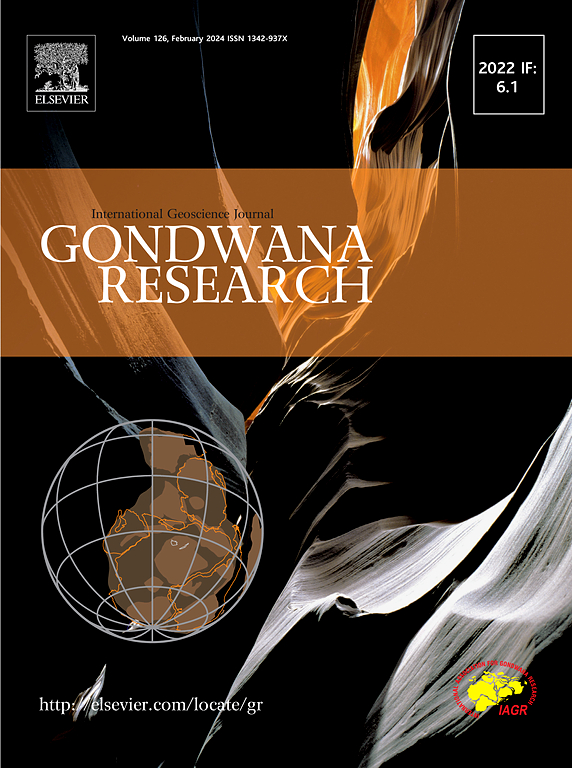The Permian-Triassic volcanic activity in the West Siberian basin: A buried silicic LIP coeval to the Siberian Traps
IF 7.2
1区 地球科学
Q1 GEOSCIENCES, MULTIDISCIPLINARY
引用次数: 0
Abstract
Traps of the Siberian platform and associated basaltic rifts in the West Siberian basin constitute one of the most voluminous continental Large Igneous Provinces (LIP). The contribution of silicic volcanic rocks to this vast province was underestimated. We present results of the first comprehensive study of silicic rocks from the Froly-Krasnoleninsky region (the central part of West Siberia). Permian-Triassic volcanics in this area are buried under the thick sedimentary cover (2.5–3.5 km) and are available only as drill cores. Volcanic rocks fill the Rogozhnikov-Nazym graben and other rifts.
The volcanic sequence in this area is dominated by lavas of rhyolitic-dacitic composition, which exhibit similar petrographic and geochemical characteristics in all studied districts. A complex of structural and geochemical features of silicic rocks corresponds to the tectonic setting of post-collisional rifting. Basalts are subordinate and similar to those from middle-upper parts of the Noril’sk volcanic section (the Siberian platform). Based on geochemical features, we suggest that silicic rocks are derived mainly from the partial melting of mafic lower continental crust due to the input of additional heat from the Siberian mantle plume. Late Paleozoic crust of the central part of West Siberia, saturated with mafic underplates during prior subduction events, provided favorable conditions for the generation of silicic magmas, while post-collisional rifts acted as magma-conducting zones.
Nine new U-Pb ages constrain the timing of silicic volcanic activity in West Siberia as ∼5–10 Myr at the Permian-Triassic boundary (253.69–248.21 Ma), which is nearly coeval to the main phase of the Siberian Traps emplacement. Temporal and spatial relationships, along the geochemical similarity of the silicic and mafic rocks confirm their genetic relations. In total, silicic rocks occupy about 105 km2 within the West Siberian basin and can be considered as a Silicic Large Igneous Province (SLIP), coeval and genetically linked to the mafic Siberian Traps LIP.

西西伯利亚盆地二叠纪-三叠纪火山活动:与西伯利亚圈闭同期的埋藏硅质LIP
西伯利亚地台圈闭及其伴生的玄武岩裂陷构成了西西伯利亚盆地面积最大的大陆大火成岩省(LIP)之一。硅质火山岩对这个广袤省份的贡献被低估了。本文介绍了首次对西西伯利亚中部Froly-Krasnoleninsky地区硅质岩石进行综合研究的结果。该地区的二叠纪-三叠纪火山被埋在厚厚的沉积盖层(2.5-3.5 km)下,只能通过钻孔岩心获得。火山岩填满了罗戈日尼科夫-纳兹姆地堑和其他裂谷。
本文章由计算机程序翻译,如有差异,请以英文原文为准。
求助全文
约1分钟内获得全文
求助全文
来源期刊

Gondwana Research
地学-地球科学综合
CiteScore
12.90
自引率
6.60%
发文量
298
审稿时长
65 days
期刊介绍:
Gondwana Research (GR) is an International Journal aimed to promote high quality research publications on all topics related to solid Earth, particularly with reference to the origin and evolution of continents, continental assemblies and their resources. GR is an "all earth science" journal with no restrictions on geological time, terrane or theme and covers a wide spectrum of topics in geosciences such as geology, geomorphology, palaeontology, structure, petrology, geochemistry, stable isotopes, geochronology, economic geology, exploration geology, engineering geology, geophysics, and environmental geology among other themes, and provides an appropriate forum to integrate studies from different disciplines and different terrains. In addition to regular articles and thematic issues, the journal invites high profile state-of-the-art reviews on thrust area topics for its column, ''GR FOCUS''. Focus articles include short biographies and photographs of the authors. Short articles (within ten printed pages) for rapid publication reporting important discoveries or innovative models of global interest will be considered under the category ''GR LETTERS''.
 求助内容:
求助内容: 应助结果提醒方式:
应助结果提醒方式:


